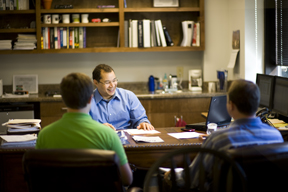A Day in the Life of a Sealevel Engineer
June 4, 2010For me, one of the draws of engineering at Sealevel is personal involvement in the full product design cycle. Throughout my engineering career I have enjoyed working with a team to bring concepts to reality, and, in particular, having visibility and influence over the project as it matures. Engineering at Sealevel is structured, hands-on, and exciting.
Following is a high-level overview of the engineering process.
Research — A key element of engineering at Sealevel is a focus on research, both in expanding existing products and exploring new technologies and applications. This is the genesis of new products and directions.
Project Definition — A project idea may come from many sources, including engineering. Once a project is defined, a marketing analysis is performed. It is the responsibility of engineering to capture the technical, cost, and schedule requirements, and to track them to completion.
Design and Development — Individual engineers have a direct impact on the design and development of projects. Through cross-discipline team interactions (electrical, software, and mechanical) a design is realized that meets the requirements.
Peer Reviews — A structured review process during development allows for design checking, improvement, and mentoring within the team. The peer review process is critical not only to check that the design meets project requirements, but to verify the design meets the Sealevel engineering design guidelines, with the goal of delivering a quality design.
Prototyping — The design is created and proven through hands-on lab testing. Here all engineering disciplines work together to verify the design meets requirements, and to develop and review any required changes to the design.
Production — Once a project is deemed complete, it is released to production. Here engineering works with manufacturing and other departments to deliver the design and finalize all the design data, work instructions, test plans, and documentation required to build, release, and support a finished product.
Lessons Learned — Any lessons learned during a project are captured and shared among the engineering staff, and incorporated into the engineering design guidelines as appropriate. This provides for growth and continuous process improvement.
The engineering environment at Sealevel is collaborative, fast-paced, challenging, and rewarding. As a hardware engineer, on any given day I am engaged in a step of the engineering process on one or more projects: I may be deep in requirements gathering, designing a board, developing an FPGA, working side-by-side with software engineering, or on the manufacturing floor bringing up a new product — just to name a few. With so many facets, engineering at Sealevel makes for a very interesting day.
Check out the Careers page to find out how you can join the Sealevel team.
